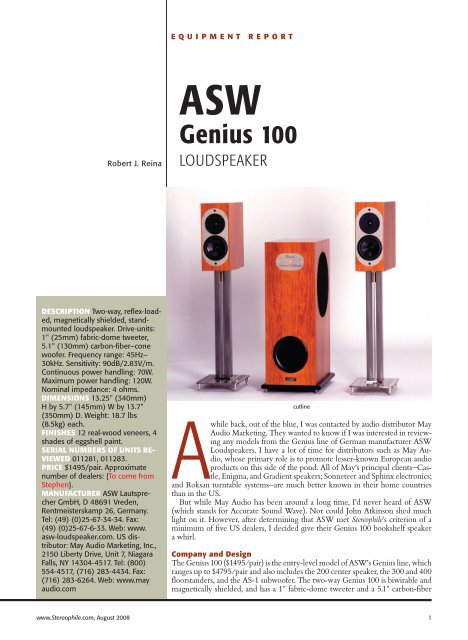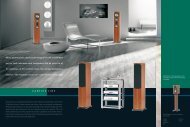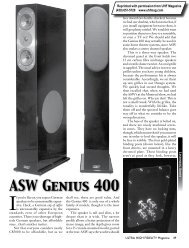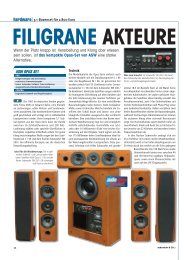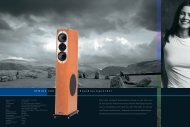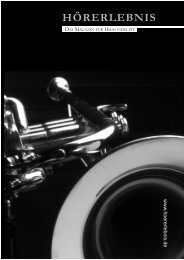You also want an ePaper? Increase the reach of your titles
YUMPU automatically turns print PDFs into web optimized ePapers that Google loves.
Robert J. Reina<br />
DESCRIPTION Two-way, reflex-loaded,<br />
magnetically shielded, standmounted<br />
loudspeaker. Drive-units:<br />
1" (25mm) fabric-dome tweeter,<br />
5.1" (130mm) carbon-fiber–cone<br />
woofer. Frequency range: 45Hz–<br />
30kHz. Sensitivity: 90dB/2.83V/m.<br />
Continuous power handling: 70W.<br />
Maximum power handling: 120W.<br />
Nominal impedance: 4 ohms.<br />
DIMENSIONS 13.25" (340mm)<br />
H by 5.7" (145mm) W by 13.7"<br />
(350mm) D. Weight: 18.7 lbs<br />
(8.5kg) each.<br />
FINISHES 12 real-wood veneers, 4<br />
shades of eggshell paint.<br />
SERIAL NUMBERS OF UNITS RE-<br />
VIEWED 011281, 011283.<br />
PRICE $1495/pair. Approximate<br />
number of dealers: {To come from<br />
Stephen}.<br />
MANUFACTURER <strong>ASW</strong> Lautsprecher<br />
GmbH, D 48691 Vreden,<br />
Rentmeisterskamp 26, Germany.<br />
Tel: (49) (0)25-67-34-34. Fax:<br />
(49) (0)25-67-6-33. Web: www.<br />
asw-loudspeaker.com. US distributor:<br />
May Audio Marketing, Inc.,<br />
2150 Liberty Drive, Unit 7, Niagara<br />
Falls, NY 14304-4517. Tel: (800)<br />
554-4517, (716) 283-4434. Fax:<br />
(716) 283-6264. Web: www.may<br />
audio.com<br />
EQUIPMENT REPORT<br />
<strong>ASW</strong><br />
<strong>Genius</strong> <strong>100</strong><br />
LOUDSPEAKER<br />
A<br />
while back, out of the blue, I was contacted by audio distributor May<br />
Audio Marketing. They wanted to know if I was interested in reviewing<br />
any models from the <strong>Genius</strong> line of German manufacturer <strong>ASW</strong><br />
Loudspeakers. I have a lot of time for distributors such as May Audio,<br />
whose primary role is to promote lesser-known European audio<br />
products on this side of the pond. All of May’s principal clients—Castle,<br />
Enigma, and Gradient speakers; Sonneteer and Sphinx electronics;<br />
and Roksan turntable systems—are much better known in their home countries<br />
than in the US.<br />
But while May Audio has been around a long time, I’d never heard of <strong>ASW</strong><br />
(which stands for Accurate Sound Wave). Nor could John Atkinson shed much<br />
light on it. However, after determining that <strong>ASW</strong> met Stereophile’s criterion of a<br />
minimum of five US dealers, I decided give their <strong>Genius</strong> <strong>100</strong> bookshelf speaker<br />
a whirl.<br />
cutline<br />
Company and Design<br />
The <strong>Genius</strong> <strong>100</strong> ($1495/pair) is the entry-level model of <strong>ASW</strong>’s <strong>Genius</strong> line, which<br />
ranges up to $4795/pair and also includes the 200 center speaker, the 300 and 400<br />
floorstanders, and the AS-1 subwoofer. The two-way <strong>Genius</strong> <strong>100</strong> is biwirable and<br />
magnetically shielded, and has a 1" fabric-dome tweeter and a 5.1" carbon-fiber<br />
www.Stereophile.com, August 2008 1<br />
STRP-080800-<strong>ASW</strong>.indd 1 5/27/08 12:41:50 PM
cone woofer. It also has silver internal<br />
wiring, high-quality connectors, and a<br />
linear, 12dB/octave, low-impedance<br />
crossover. According to <strong>ASW</strong>, their design<br />
goals for the <strong>100</strong> were optimum<br />
spatial imaging and tonal balance for<br />
both music and home-theater. And as<br />
this modestly sized bookshelf model is<br />
intended to complement Bauhaus furniture<br />
design, the speaker is available in<br />
12 real-wood veneers and four choices<br />
of eggshell paint. My sample, in cherry,<br />
was quite attractive.<br />
I placed the <strong>ASW</strong>s on Celestion Si<br />
stands loaded with sand and lead shot. I<br />
disagree with May Audio’s recommendation<br />
to remove <strong>Genius</strong> <strong>100</strong>’s cloth<br />
grille. Although I did hear more inner<br />
detail and transparency with the grilles<br />
MEASUREMENTS<br />
<strong>ASW</strong> GENIUS <strong>100</strong><br />
My estimate of the <strong>ASW</strong> <strong>Genius</strong> <strong>100</strong>’s voltage<br />
sensitivity on its tweeter axis was<br />
88dB(B)/2.83V/m, which is slightly above<br />
average but 2dB lower than the specification.<br />
The speaker’s impedance did drop to 4 ohms<br />
around 200Hz, and there is a combination of 5.8 ohms<br />
and –40° electrical phase angle at 130Hz, but overall,<br />
the <strong>ASW</strong> is not as hard to drive as its 4 ohm specification<br />
would suggest.<br />
The traces in fig.1 are free of the winkles that would<br />
imply the existence of cabinet resonances. While investigation<br />
of the panels’ vibrational behavior with an<br />
accelerometer did uncover a strong mode around 750Hz<br />
(fig.2), I feel that this is too high in frequency to have<br />
any subjective consequences.<br />
The low-frequency saddle centered at 51Hz in the<br />
impedance-magnitude trace suggests that this is the tuning<br />
frequency of the reflex port on the rear panel, which is<br />
confirmed by the minimum-motion notch in the woofer’s<br />
nearfield response (fig.3, blue trace) at the same frequency.<br />
The port’s output (fig.3, green) is a classic bandpass<br />
centered on the tuning frequency, and its upper-frequency<br />
rolloff is commendably free of resonant modes. The<br />
woofer can be seen to cross over to the tweeter (fig.3,<br />
Fig.1 <strong>ASW</strong> <strong>Genius</strong> <strong>100</strong>, electrical impedance (solid) and phase (dashed).<br />
(2 ohms/vertical div.)<br />
off, I much preferred the more coherent,<br />
more balanced timbres that the<br />
grilles provided. On they stayed.<br />
Listening<br />
I began my listening with Patricia Barber<br />
singing “A Touch of Trash,” from<br />
her Modern Cool (SACD, Mobile Fidelity<br />
UDSACD 20003, CD layer). This<br />
immediately highlighted the <strong>Genius</strong><br />
<strong>100</strong>’s greatest strength: a voluptuous,<br />
uncolored, extremely detailed midrange<br />
that gave well-recorded female voices a<br />
stunning, lifelike quality. Barber’s voice<br />
had a rich, holographic quality through<br />
the <strong>ASW</strong>s, and I found it easy to hear<br />
the subtle envelope of reverberation<br />
that engineer Jim Anderson had used,<br />
and which was perfectly integrated<br />
with her voice. I had a similar reaction<br />
to the voice of soprano Kendra Shank,<br />
on Timothy Seelig and the Turtle Creek<br />
Chorale’s recording of John Rutter’s Requiem<br />
(CD, Reference RR-57CD). During<br />
the naturally long decay of Shank’s<br />
voice, it was easy to discern the size of<br />
the recording venue (a church). Moreover,<br />
all of the woodwinds were timbrally<br />
perfect, with tons of natural air.<br />
The <strong>Genius</strong> <strong>100</strong>’s midrange capabilities<br />
were also a good match for classical<br />
solo piano. In the Adagio of Beethoven’s<br />
Piano Sonata 1, from JA’s recording of<br />
Robert Silverman performing all 32 sonatas<br />
(CD, OrpheumMasters KSP830),<br />
the <strong>ASW</strong> revealed, as through a window<br />
opened on the music, the airy,<br />
delicate warmth of Silverman’s touch<br />
red) in a well-behaved manner at around 3.5kHz, with the<br />
latter balanced a couple of dB too high in level.<br />
The <strong>Genius</strong> <strong>100</strong>’s farfield response with its grille off<br />
(which is how it measured best), averaged across a 30°<br />
horizontal angle on the tweeter axis, is shown to the<br />
Fig.2 <strong>ASW</strong> <strong>Genius</strong> <strong>100</strong>, cumulative spectral-decay plot calculated from the<br />
output of an accelerometer fastened to the center of the sidewall<br />
(MLS driving voltage to speaker, 7.55V; measurement bandwidth,<br />
2kHz).<br />
Fig.3 <strong>ASW</strong> <strong>Genius</strong> <strong>100</strong>, acoustic crossover on tweeter axis at 50", with the<br />
tweeter shown in red and the nearfield responses of the woofer<br />
(blue) and port (green), plotted in the ratios of the square roots of<br />
their radiating areas below 350Hz and 750Hz, respectively.<br />
www.Stereophile.com, August 2008 3<br />
STRP-080800-<strong>ASW</strong>.indd 3 5/27/08 12:41:50 PM
in the instrument’s middle lower register.<br />
I was also impressed with the <strong>100</strong>’s<br />
abilities in the highs, which were clean,<br />
extended, and uncolored, with very coherent<br />
integration with the midrange<br />
timbres (with the grilles on, of course).<br />
Back to Patricia Barber’s “A Touch of<br />
Trash”: the textures of the close-miked<br />
singer’s sibilants were clean, crisp, and<br />
extended. Mark Walker’s drums and<br />
cymbals were silky but appropriately<br />
splashy, and Dave Douglas’s trumpet<br />
solo had exquisitely brassy bite.<br />
Hand in hand with the <strong>Genius</strong> <strong>100</strong>’s<br />
high-frequency abilities went its superb<br />
delineation of transient attacks, as well<br />
as its organic and linear re-creation of<br />
the entire dynamic-range envelope.<br />
Given that, I wanted to listen to a<br />
measurements, continued<br />
<strong>ASW</strong> GENIUS <strong>100</strong><br />
right of fig.4. It is fairly flat from the midrange through<br />
the mid-treble, but the top octave is elevated. I suspect<br />
that this is why BJR found that sibilants sounded “clean,<br />
crisp, and extended” rather than the speaker sounding<br />
bright per se, which tends to correlate with problems<br />
in the mid-treble. The complex sum of the woofer and<br />
port nearfield responses, taking into account acoustic<br />
phase and the different distance of each radiator from<br />
a nominal farfield point, is shown below 300Hz in fig.4.<br />
The usual hump in the upper bass that results from<br />
the nearfield measurement technique is suppressed,<br />
implying that the reflex alignment is overdamped, which<br />
would favor definition over bass weight. I note that BJR<br />
was impressed by the <strong>Genius</strong> <strong>100</strong>’s low-frequency clarity.<br />
The speaker’s bass rolls off with the expected 24dB/<br />
octave slope below the port tuning frequency.<br />
The <strong>ASW</strong>’s plot of lateral dispersion (fig.5) indicates<br />
that the woofer’s 4" cone gets a little more directional<br />
above 1kHz than I would have anticipated, with then a<br />
slight off-axis flare apparent in the bottom octave of the<br />
tweeter’s passband. I wouldn’t have expected this to lead<br />
to the brightness BJR noted when he played the speaker<br />
Fig.4 <strong>ASW</strong> <strong>Genius</strong> <strong>100</strong>, anechoic response averaged across 30° horizontal<br />
window on tweeter axis at 50” and corrected for microphone<br />
response, with the complex sum of the nearfield responses plotted<br />
below 300Hz.<br />
lot of percussion recordings through<br />
the <strong>ASW</strong>s, and began with drummer<br />
Mark Flynn’s introduction to “Blizzard<br />
Limbs,” from our band Attention<br />
Screen’s Live at Merkin Hall (CD,<br />
Stereophile STPH018-2). I marveled<br />
at how the <strong>Genius</strong> <strong>100</strong> followed every<br />
nuance of Mark’s subtle dynamic<br />
phrasing on kick drum: Each thwack<br />
had a subtly different volume level,<br />
along with a very slight change in pitch<br />
between the softest and loudest kicks.<br />
Charles Wuorinen’s Ringing Changes<br />
for Percussion Ensemble (LP, Nonesuch<br />
H71263) was a total—almost a literal—<br />
blast. I could follow every instrument<br />
across the wide, deep soundstage of<br />
the recording venue; each had its own<br />
dynamic envelope, frequency pattern,<br />
and distance from the microphones.<br />
This recording’s wide swings between<br />
the extremes of the dynamic spectrum<br />
made the <strong>Genius</strong> <strong>100</strong> sound like a<br />
much larger speaker.<br />
Nor did the little <strong>Genius</strong> hesitate to<br />
bloom with larger-scale orchestral recordings.<br />
I played Penderecki’s Credo,<br />
as performed by Helmuth Rilling and<br />
the Oregon Bach Festival Orchestra<br />
and Chorus (CD, Hänssler Classic<br />
CD 98.311). The voice of bass Thomas<br />
Quasthoff was rendered with eerie<br />
verisimilitude, and I heard no trace of<br />
congestion during the hairiest fortissimi<br />
of massed choral voices. Even in the<br />
densest passages, I could still pick out<br />
from this work’s cacophonous rubble<br />
each individual brass line.<br />
at high volumes. The tweeter is considerably more directional<br />
above 10kHz than is usual for a 1" dome. In rooms<br />
of normal size, this will tend to counteract the on-axis<br />
boost in the same region. The plot of the <strong>Genius</strong> <strong>100</strong>’s<br />
vertical dispersion (fig.6) suggests that the speakers be<br />
used with stands that place the listener’s ears level with<br />
or below the tweeter. A major suckout develops in the<br />
crossover region immediately above that axis.<br />
Fig.5 <strong>ASW</strong> <strong>Genius</strong> <strong>100</strong>, lateral response family at 50", normalized to response<br />
on tweeter axis, from back to front: differences in response<br />
90–5° off axis, reference response, differences in response 5–90° off<br />
axis.<br />
Fig.6 <strong>ASW</strong> <strong>Genius</strong> <strong>100</strong>, vertical response family at 50", normalized to<br />
response on tweeter axis, from back to front: differences in response<br />
45–5° above axis, reference response, differences in response 5–45°<br />
below axis.<br />
www.Stereophile.com, August 2008 5<br />
STRP-080800-<strong>ASW</strong>.indd 5 5/27/08 12:41:50 PM
The <strong>Genius</strong> <strong>100</strong>’s superb bass performance<br />
revealed another dimension<br />
of jazz and classical recordings. For a<br />
bookshelf speaker, its midbass extension<br />
with all recordings was surprisingly<br />
forceful and uncolored. Ray Brown’s<br />
solo on “I’m an Old Cowhand,” from<br />
Sonny Rollins’ Way Out West (CD, JVC<br />
VICJ-60088), was even throughout the<br />
double bass’s entire range, as well as<br />
uncolored and well defined, if slightly<br />
warm in the instrument’s lower register,<br />
as it should be. The organ pedals in<br />
the Rutter Requiem were clean, forceful,<br />
and extended. Although the <strong>Genius</strong><br />
<strong>100</strong>s didn’t shake my room, I can’t<br />
think of another bookshelf speaker<br />
I’ve heard that could more realistically<br />
reproduce the sound of organ-pedal<br />
notes. Finally, Tyler Mack’s solo timpani<br />
passages in Tomiko Kohjiba’s Transmigration<br />
of the Soul, from the Santa Fe<br />
Chamber Music Festival’s Festival (CD,<br />
Stereophile STPH007-2), sounded natural<br />
and vibrant.<br />
I discovered a paradox about the<br />
<strong>Genius</strong> <strong>100</strong>. You’d think a bookshelf<br />
speaker able to produce such realistic<br />
bass and such wide dynamic swings<br />
wouldn’t mind being cranked up to<br />
high volume levels, and sure enough—<br />
with more demanding and complex<br />
recordings played at louder volumes,<br />
measurements, continued<br />
<strong>ASW</strong> GENIUS <strong>100</strong><br />
The <strong>ASW</strong>’s step response on the tweeter axis (fig.7)<br />
reveals that the two drive-units are connected with the<br />
same positive acoustic polarity, and that the decay of<br />
the tweeter’s step is neatly integrated with that of the<br />
woofer. Some slight low-frequency ringing can be seen<br />
in the decay of the woofer step, which is also evident in<br />
the speaker’s cumulative spectral-decay plot (fig.8) as the<br />
small amount of delayed energy just above 1kHz. This<br />
graph is otherwise superbly free of resonant modes, so<br />
Fig.7 <strong>ASW</strong> <strong>Genius</strong> <strong>100</strong>, step response on tweeter axis at 50" (5ms time<br />
window, 30kHz bandwidth).<br />
the <strong>ASW</strong>’s bass performance and sense<br />
of dynamic slam began to resemble<br />
those of a more expensive floorstander.<br />
The problem was<br />
that, as I raised the<br />
volume level with<br />
these recordings,<br />
the high frequencies<br />
began to lose<br />
their tonal purity.<br />
For example, I<br />
cut loose at fairly<br />
high levels with<br />
“Dog Breath Variations”<br />
and “Uncle<br />
Meat” from The<br />
Yellow Shark, Peter<br />
Rundel and Ensemble<br />
Modern’s<br />
recording of orchestral<br />
music by Frank<br />
Zappa (CD, Barking<br />
Pumpkin R2<br />
71600). In the more<br />
highly modulated<br />
passages the high<br />
frequencies became<br />
a touch wiry, even the glockenspiel. I<br />
experimented with the volume with<br />
“Man Machine,” from Kraftwerk’s<br />
Minimum/Maximum (CD, EMI <strong>ASW</strong><br />
60611). At medium volumes, the bass<br />
instruments were forceful and punchy,<br />
with great dynamic slam, and the fast,<br />
zippy, high-frequency transients were<br />
appropriately crisp on top. However, as<br />
I increased the volume<br />
to concert levels, the<br />
crispness took on that<br />
same wiry quality.<br />
At extreme volumes,<br />
the <strong>Genius</strong> <strong>100</strong><br />
sounded bright. In an<br />
attempt to replicate<br />
rock-concert levels, I<br />
spun Jeff Beck’s rendition<br />
of Stevie Wonder’s<br />
“Because We’ve Ended<br />
as Lovers,” from Eric<br />
Clapton’s Crossroads<br />
Guitar Festival (DVD,<br />
Rhino R2 35212 4);<br />
the <strong>ASW</strong>s overemphasized<br />
Beck’s guitar.<br />
I then cranked up the<br />
title track of Hole’s Celebrity<br />
Skin (CD, Geffen<br />
DGCD-25464) to the<br />
level (+<strong>100</strong>dB) at which<br />
I start to dance around<br />
the room, and all voices and instruments<br />
were quite blarey in the highs.<br />
But at normal listening levels, the <strong>Genius</strong><br />
<strong>100</strong> was a pleasure to listen to with<br />
a broad range of material. In the André<br />
Previn performance of Messiaen’s<br />
I’m not sure what led BJR to find that the speaker sounded<br />
bright at high levels. Most probably, given his comments<br />
about playback level, it was distortion from the<br />
small woofers being asked to move more air than they<br />
are capable of, the <strong>Genius</strong> <strong>100</strong>’s overall clarity leading the<br />
listener to inadvertently play music at louder levels than a<br />
less-clear small speaker might tempt him to do.<br />
Overall, its measurements reveal that this little German<br />
speaker demonstrates some excellent engineering.<br />
—John Atkinson<br />
Fig.8 <strong>ASW</strong> <strong>Genius</strong> <strong>100</strong>, cumulative spectral-decay plot on tweeter axis at<br />
50" (0.15ms risetime).<br />
www.Stereophile.com, August 2008 7<br />
STRP-080800-<strong>ASW</strong>.indd 7 5/27/08 12:41:51 PM<br />
cutline
Turangalîla Symphony (UK LP, EMI SLS<br />
5117), the upper-register piano transients<br />
were startling but delicate, and it<br />
was easy to pick out the bassoon figures<br />
way down in the mix. I could hear the<br />
subtle dynamic inflections of the gong,<br />
and the <strong>Genius</strong> <strong>100</strong>’s excellent clarity<br />
allowed me to focus on the interplay of<br />
WhEn nOt PUSHED<br />
tOO hARD, thE <strong>ASW</strong><br />
GEniUS <strong>100</strong> WAS A<br />
DEtAiLED, nEUtRAL,<br />
DyNAMIC-SOUND-<br />
ING PERfORmER thAt<br />
bREAthED LiKE LivE mU-<br />
Sic OvER A WiDE RAnGE<br />
Of PROGRAm<br />
MATERIAL.<br />
cello and clarinet while ignore all the<br />
other instruments. The bass-drum blast<br />
at the end of the Turangalîla 2 movement<br />
could not have sounded more<br />
natural or dramatic. A recording that<br />
put all of the <strong>ASW</strong>’s strengths together<br />
was Antal Dorati and the London<br />
Symphony’s of Stravinsky’s The Firebird<br />
(LP, Mercury Living Presence/Classic<br />
SR 90226). I could easily focus on the<br />
tutti pizzicato strings’ subtle crescendo<br />
from ppp to p, and was able to clearly<br />
follow each trombone. All instruments<br />
breezed through high-level passages<br />
effortlessly without strain; the bass<br />
drum even shook the room a bit.<br />
Comparisons<br />
I compared the <strong>ASW</strong> <strong>Genius</strong> <strong>100</strong><br />
($1395) with the Nola Mini ($695<br />
when last offered), the Amphion Helium<br />
2 ($<strong>100</strong>0), and the Monitor Audio<br />
Silver RS6 ($<strong>100</strong>0). All speaker prices<br />
are per pair.<br />
The Nola Mini’s midrange was as<br />
impressive as the <strong>ASW</strong>’s, although<br />
the <strong>Genius</strong> <strong>100</strong> had a slightly richer<br />
quality there. High-frequency sibilants<br />
seemed a bit clearer through the<br />
<strong>ASW</strong>, but the Nola’s bass extension<br />
and high-level dynamic performance<br />
were superior. However, the Nola’s<br />
midbass seemed a bit warmer overall<br />
than the <strong>ASW</strong>’s.<br />
The Amphion Helium 2 shared the<br />
<strong>ASW</strong> GENIUS <strong>100</strong><br />
<strong>Genius</strong> <strong>100</strong>’s pure, silky midrange and<br />
revealed even more detail, but its highs<br />
were sweeter, more romantic and airy,<br />
with a high level of detail. Bass extension<br />
and high-level dynamics were inferior<br />
to the <strong>ASW</strong>’s, however.<br />
The floorstanding Monitor Audio<br />
Silver RS6, too, revealed considerable<br />
midrange detail, and its high frequencies<br />
were clean and crisp, with lightning-fast<br />
transients, although the <strong>Genius</strong><br />
<strong>100</strong> had a bit more air at the very<br />
top. The Monitor’s bass extension and<br />
high-level dynamics, however, were<br />
the best of the four.<br />
Punchline<br />
I was very pleased with all of the listening<br />
time I spent with the <strong>ASW</strong> <strong>Genius</strong><br />
<strong>100</strong>. When not pushed too hard, this<br />
loudspeaker was a detailed, neutral,<br />
dynamic-sounding performer that<br />
breathed like live music over a wide<br />
range of program material. Moreover,<br />
it’s attractive and a good value. I hope<br />
that <strong>ASW</strong> becomes a greater presence<br />
in the US; more audiophiles should get<br />
the chance to audition their speakers.<br />
nn<br />
ASSOCIATED EQUIPMENT<br />
ANALOG SOURCES VPI TNT IV<br />
turntable, Immedia RPM tonearm,<br />
Koetsu Urushi cartridge; Rega Planar<br />
3 turntable, Syrinx PU-3 tonearm,<br />
Clearaudio Virtuoso Wood & Aurum<br />
Beta S cartridges.<br />
DIGITAL SOURCES Lector CDP-7T,<br />
Creek Destiny CD players; Pioneer<br />
DV-333 DVD player.<br />
PREAMPLIFICATION Vendetta Research<br />
SCP-2D phono stage, Audio<br />
Valve Eklipse line stage.<br />
POWER AMPLIFIER Audio Research<br />
Reference 110 II.<br />
INTEGRATED AMPLIFIERS Creek<br />
Destiny & 5350SE.<br />
LOUDSPEAKERS Nola Mini,<br />
Amphion Helium2, Monitor Audio<br />
Silver RS6.<br />
CABLES Interconnect (all MIT):<br />
Magnum M3, MI-350 CVTwin<br />
Terminator, MI-330SG, Terminator.<br />
Speaker: Acarian Systems Black<br />
Orpheus.<br />
ACCESSORIES Various by ASC,<br />
Bright Star, Celestion, Echo Busters,<br />
Salamander Designs, Simply Physics,<br />
Sound Anchor, VPI.<br />
—Robert J. Reina<br />
www.Stereophile.com, August 2008 9<br />
STRP-080800-<strong>ASW</strong>.indd 9 5/27/08 12:41:51 PM


